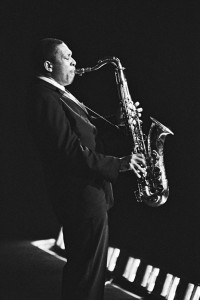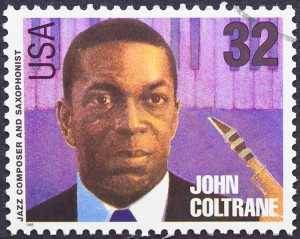Coltrane 50: The Last Giant Steps
July 18, 2017
Yesterday, July 17, marked the 50th anniversary of the death of jazz legend John Coltrane. Known for his searing saxophone solos and sometimes shocking originality, Coltrane is regarded as one of the finest artists in the history of jazz. Over the course of his brief life and career—he was just 40 when he died—Coltrane left behind a rich and powerful trail of music that continues to enthrall and influence musicians today. The great “Trane” died on July 17, 1967.

American jazz musician John Coltrane, who died 50 years ago this week, performs at the Olympia Theatre in Paris, France, in 1963. Credit: © Herve Gloaguen, Gamma-Rapho/Getty Images
A number of Coltrane memorial albums were released in 2017, and the broad swath of memorial concerts on the 50th anniversary of his death speak to the musician’s international and long-lasting appeal. Current jazz legends performed (or are about to perform) Coltrane classics at venues across the United States as well in France, Japan, Spain, the United Kingdom, and other countries. Coltrane has also been the subject of a number of recent books and documentaries recounting his life and trying to explain his largely unexplainable talent. When asked how he composed and played his music, Coltrane said, “I start from one point and go as far as possible. But, unfortunately, I never lose my way.”
John William Coltrane was born on Sept. 23, 1926, in Hamlet, North Carolina. As a youth, he learned to play E-flat horn and clarinet. While in high school in Philadelphia, Coltrane became enamored with the works of jazz greats Johnny Hodges and Lester Young. He took up the alto saxophone and studied at the local Granoff and Ornstein schools of music. Toward the end of World War II (1939-1945), Coltrane joined the U.S. Navy. Stationed in Hawaii, he played in base bands and met other musicians from across the United States.
After the war, Coltrane performed with Jimmy “Little Bird” Heath and played tenor saxophone with the Eddie “Cleanhead” Vinson Band. Beginning in 1949, Coltrane achieved national prominence with bands led by Dizzy Gillespie and then Johnny Hodges, his high school hero. As part of the Miles Davis quintet between 1955 and 1960, Coltrane’s individuality began to shine with complex and exhausting solos that gave extra punch to Davis’s already brilliant compositions. At the same time, Coltrane performed and recorded with such jazz legends as Cannonball Adderley, Eric Dolphy, Thelonious Monk, and Lee Morgan. Leading his own band, Coltrane’s mesmerizing 1957 album Blue Train showcased his ever-expanding musical talent. The first album entirely composed by Coltrane was the 1959 classic Giant Steps.
In 1960, Coltrane scored a popular success with a recording of the song “My Favorite Things” (on which he played soprano saxophone). In 1961, his energetic Olé Coltrane wowed jazz aficionados as well as his newly won fans. In 1962, Coltrane assembled what came to be known as his “classic” quartet. It most often included McCoy Tyner on piano, Jimmy Garrison on bass, and Elvin Jones on drums. The quartet’s albums include Coltrane, Impressions, and the monumental A Love Supreme. In 1965, Coltrane’s Ascension inspired many younger jazz musicians to work in the experimental style known as free jazz.
During the last years of his life, Coltrane became a role model among many fans because of his support of experimental jazz, his idealistic search for perfection in his music, and his passionate religious beliefs. Coltrane died on July 17, 1967, after a sudden and short fight with liver cancer. After his death, devoted followers established a new church in Coltrane’s honor in San Francisco, proclaiming him to be a saint. In 2007, he was honored with a Pulitzer Prize special citation ”for his masterful improvisation, supreme musicianship and iconic centrality to the history of jazz.”



